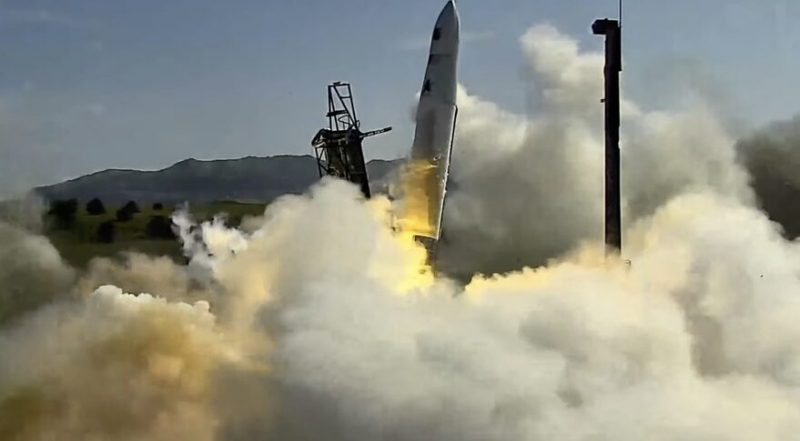
Astra to attempt launch
The fledgling commercial rocket company Astra Space Inc. – aka Astra – hopes to launch a test payload for the U.S. Space Force in early November 2021. This launch will be Astra’s fourth attempt at reaching orbit. It’s also the company’s second time using the fifth iteration of the third version of its small-sat launch vehicle, the Rocket 3.4 (Launch Vehicle 0007). Astra had initially planned for a launch on October 28 but wrote that preparations “would not finish in time” for their first launch window. Now, they plan to launch during a window that opens at midnight EDT (04:00 UTC) on November 5 and runs through November 7. Astra will livestream the event on their website. As Tim Fernholz wrote in Quartz on August 30, 2021:
In the space transportation business, the first launch is all-important – and hard to do. SpaceX nearly went bankrupt pushing through the three failed launches of its first rocket, the Falcon 1. Rocket Lab and Virgin Orbit both saw their first flight tests go south before proving they could put satellites on orbit.
The coming launch attempt by Astra will be from Launch Pad 3B at the Astra Spaceport in Kodiak, Alaska, where another attempted launch ended in a fiery explosion in September 2020.
We’re proud of our team for getting us back to the pad in 60 days. After the team & LV0007 arrived in Kodiak, we learned planned range improvements would not finish in time to complete the necessary preparations for a launch in 1st segment of our window. Stay tuned. #AdAstra
— Astra (@Astra) October 26, 2021
The U.S. Space Force is part of the Department of Defense (DoD). The payload, called STP-27AD2, is the second of two test launches for DoD as part of the Space Force’s Space Test Program. Not much is known about the plans the DoD has for these missions, due to the classified nature of the program. But STP-27AD2 will most likely be an experimental simulator like STP-27AD1, allowing Astra and the DoD to validate what mass Rocket 3 can carry.
The Rocket 3.3 anomaly on August 28
Astra also announced its findings from an investigation into the previous launch, on August 28, 2021, which was aborted. Instead of rising smoothly off the launch pad, that rocket lurched sideways at the moment of liftoff.
The rocket reached an altitude of about 20.5 miles (33 km) and flew for 2 1/2 minutes before shutting down. Controllers terminated the flight right around “max q,” the height at which mechanical stresses on the rocket are highest. A camera mounted on the booster showed a piece breaking loose then. During liftoff, fuel and liquid oxygen leaked from the propellant supply system. According to Astra’s statement, the leaked propellants mixed and ignited, which disabled one of the five first-stage engines.
Carolina Grossman, the director of product management at Astra, said during a livestream of the event:
As we dig into the flight data, we are optimistic about the future and our next attempt.
Astra has boasted confidently about reaching orbit this time, claiming to have implemented changes to prevent its previous failures from repeating. It is learning, after all. It addressed the fuel-consumption issue and spent time upgrading its booster variant, the company says.
Other Astra problems
Astra attempted two other orbital flight tests before the launch on August 28, but neither carried a payload. And, unfortunately, neither was successful. In September 2020, Astra’s Rocket 3.1 suffered a software issue that came shortly after launch, causing it to crash back to Earth soon after. Then in December, Rocket 3.2 just nearly made it to space but ran out of fuel before reaching orbital velocity.
The rocket before those – Rocket 3.0 – failed during ground testing due to a stuck-open valve while de-tanking the vehicle.
4th launch attempt the charm?
The California Bay Area startup, founded in 2016, aims for the growing small-satellite launch market. Astra claims that its rockets are mass-produced and low-cost. Notably, it has a reputation for being highly mobile. Its rockets, for example, travel to launch sites in standard shipping containers.
Astra co-founder and CTO Adam London said in a Q&A that the company posted:
You don’t find any rockets today that are that affordable. Astra was put together to figure out how you bridge that gap: how you make lots of rockets, so people can leverage easier and faster access to space to do great and interesting things …
Our next objective is monthly, then weekly, and finally daily space delivery. It’s a little nuts, but if you have a satellite in orbit and it fails, you need to put another one back there quickly. Or, if you want to launch a constellation of thousands of satellites, you don’t want to wait six months between launches. Our idea is by launching a few satellites nearly every day to precisely where they are needed, you can have a constellation deployed in a year or two rather than five years.
Astra is also developing a satellite bus. These spacecraft will sport electric-propulsion engines manufactured by Apollo Fusion, which Astra acquired earlier this year.
Bottom line: Astra will be launching a test payload for the United States Space Force in early November 2021. It will be Astra’s fourth attempt at reaching orbit, taking off from Launch Pad 3B at the Astra Spaceport in Kodiak, Alaska. The current launch window opens at midnight EDT (04:00 UTC) on November 5 and goes through November 7.
The post Another Astra launch is imminent first appeared on EarthSky.
0 Commentaires